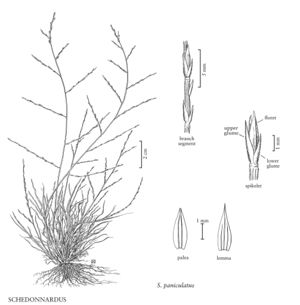| Taxon | Illustrator ⠉ | |
|---|---|---|
 | Schedonnardus paniculatus | Karen Klitz Linda A. Vorobik |
Plants perennial; cespitose. Culms 8-55 cm, sometimes geniculate and branched basally, usually curving distally; internodes minutely retrorsely pubescent, mostly solid. Leaves mostly basal; sheaths compressed-keeled, closed, glabrous, margins scarious; ligules 1-3.5 mm, membranous, lanceolate; blades 1-12 cm long, 0.7-2 mm wide, stiff, usually folded, often spirally twisted, midrib well-developed, margins thick and whitish. Inflorescences terminal, panicles of widely spaced, racemosely arranged, spikelike branches, exceeding the upper leaves; branches strongly divergent, with distant to slightly imbricate, closely appressed spikelets. Spikelets 3-5.5 mm, mostly sessile, compressed laterally, with 1 floret; florets bisexual; disarticulation at the base of the panicle and above the glumes. Glumes lanceolate, unequal, 1-veined; lemmas usually exceeding the glumes, 3-veined, unawned or shortly awned; paleas subequal to the lemmas; anthers 3; styles 2. Caryopses fusiform, x = 10.
Distribution
Alta., Man., Sask., Wyo., Nev., Colo., N.Mex., Tex., La., Utah, Calif., Minn., Kans., N.Dak., Nebr., Okla., S.Dak., Mont., Pacific Islands (Hawaii), Ill., Miss., Iowa, Ariz., Mo., Ark., Wis.
Discussion
Schedonnardus is a monotypic North American genus that grows in the prairies and central plains of Canada, the United States, and northwestern Mexico. It has also been found, as a recent introduction, in California and Argentina. It is not known if it is established in California.
Selected References
None.
Lower Taxa
"decumbent" is not a number.